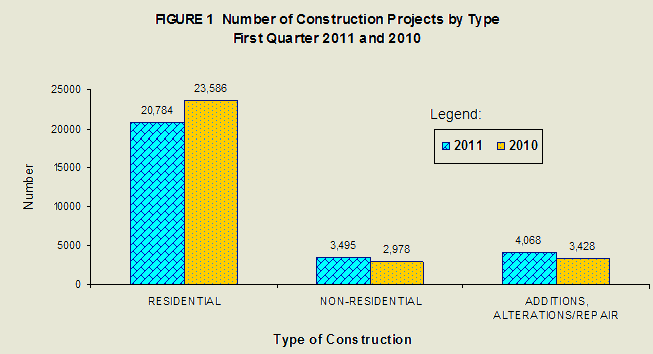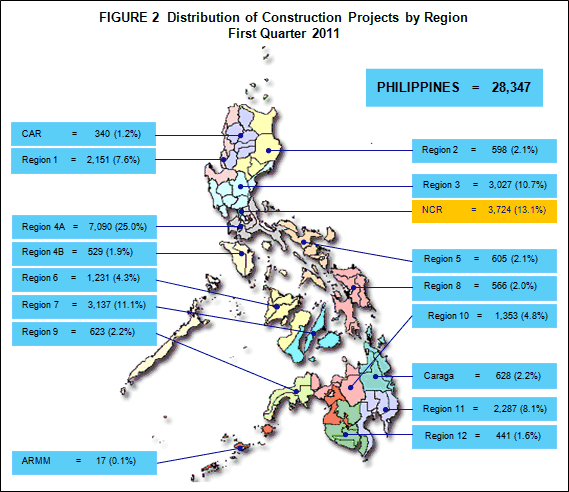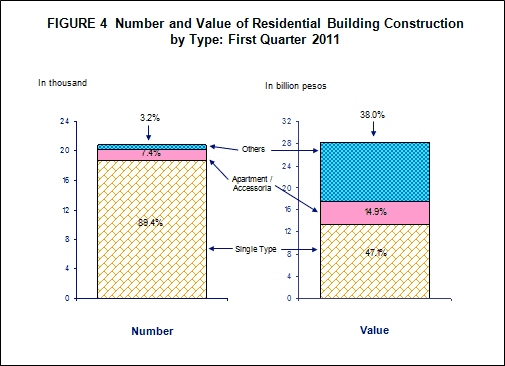Construction projects post 28,347 in the first quarter
-
The country's construction projects from approved building permits summed up to 28,347 during the first quarter of 2011. This reflects a 5.5 percent annual decrease from 29,992 constructions projects during the same period in 2010.
-
Residential type building in the first quarter of 2011 recorded a total of 20,784, down by 11.9 percent than last year's total residential construction of 23,586. On the other hand, non-residential construction for the period grew 17.4 percent to 3,495 from 2,978 during the same quarter of 2010.
-
Furthermore, combined approved building permits for additions, alterations and repairs with a total of 4,068 rose by 18.7 percent from 3,428 approved building permits recorded during the same quarter of 2010. Figure 1 compares the number of approved building permits by type of construction for the first quarters of 2010 and 2011.

-
The most number of construction projects in the country were located in CALABARZON (Region IVA) with 7,090 or 25.0 percent of the total. National Capital Region (NCR) with 3,724 constructions (13.1%) ranked second, followed by Central Visayas (Region VII) with 3,137 constructions representing 11.1 percent of the total. Central Luzon (Region III) with 3,027 constructions (10.7%) and Davao Region (Region XI) with 2,287 constructions (8.1%) ranked fourth and fifth, respectively.
-
At the provincial level, Cavite reported the biggest number of construction projects with 2,785 or 9.8 percent of the total. This was followed by the province of Cebu with 1,620 (5.7%) construction projects. Other provinces which exceeded a thousand mark were Laguna with 1,547 (5.5%), Davao del Sur, 1,291 (4.6%), Rizal, 1,196 (4.2%) and Batangas with 1,096 (3.9%) construction projects during the first quarter 2011. Figure 2 shows the distribution of construction projects by region.

Total value of construction surges 11.6% to PHP52.8 billion
-
Total value of construction during the first quarter of 2011 surged 11.6 percent to PHP52.8 billion from PHP47.3 billion recorded during the same quarter of 2010.
-
Similarly, value of residential building construction exhibited an increase of 32.6 percent amounting to PHP28.2 billion from PHP21.3 billion during the same quarter of 2010.
-
Value of non-residential building construction, however, dropped 13.2 percent amounting to PHP19.4 billion from PHP22.3 billion registered during the same period of 2010.
-
Furthermore, combined value for additions, alterations and repairs, estimated at PHP5.2 billion, increased by 39.7 percent from PHP3.7 billion registered during the same period of 2010. Figure 3 compares the aggregate value of construction by type of building for the first quarters of 2010 and 2011.

-
Across the country, value of construction for the National Capital Region (NCR) had always remained highest at PHP25.1 billion, accounting for 47.6 percent share of the total value. CALABARZON (Region IVA), and Central Luzon (Region III) ranked a far second and third with respective shares of 13.7 percent (PHP7.2 billion) and 8.1 percent (PHP4.3 billion).
Average cost per square meter of residential building construction is PHP8,654
-
Total value of construction for residential buildings was PHP28.2 billion with a total floor area of 3.3 million square meters, translating to an average cost of PHP8,654 per square meter. This represents a slight increase of 6.5 percent compared with the average cost of PHP8,126 per square meter of the previous year.
-
Among the residential construction, single type recorded the most number of projects with 18,573 (89.4%). Total value of construction for this type reached PHP13.3 billion covering a total floor area of 1.7 million square meters translating to an average cost of PHP7,608 per square meter.
-
Apartment/accessoria followed next with 1,538 construction projects representing 7.4 percent of total residential construction. This type of residential building construction had an estimated construction value of PHP4.2 billion with total floor area of 571.1 thousand square meters or an average cost of PHP7,354 per square meter.
-
Duplex type residential building recorded a total of 559 construction projects or 2.7 percent of the total residential construction. Total value for this type amounted to PHP619.8 million and a total floor area of 75.1 thousand square meters or an average cost of PHP8,257 per square meter. Figure 4 displays the percentage distribution of the number and value of residential building construction by type for the first quarter of 2011.

Commercial type dominates non-residential building construction with 2,136
-
During the first quarter of 2011, value of non-residential building construction was PHP19.4 billion pesos with a total floor area of 2.1 million square meters. This translates to an average cost of PHP9,220 per square meter.
-
Commercial type dominated all other types of non-residential building construction with 2,136 projects (61.1%). Value of construction for this type was estimated at PHP12.7 billion covering a total floor area of 1.3 million square meters or an average cost of PHP9,939 per square meter.
-
Institutional building construction ranked a far second with 532 construction projects (15.2%), construction value of PHP4.0 billion and a total floor area of 339.8 thousand square meters or an average cost of PHP11,647 per square meter.
-
This was followed by industrial type building construction with 411 construction projects (11.8%). The total value of industrial construction amounted to PHP2.1 billion with a total floor area of 376.3 thousand square meters. This expresses to an average cost of PHP5,456 per square meter.
-
The least number of non-residential construction was reported for agricultural type with 150 or 4.3 percent of the total. Construction value was estimated at PHP328.2 million covering a total floor area of 105.5 thousand square meters, translating to an average cost of PHP3,112 per square meter. Figure 5 shows the number and value of non-residential building construction by type for the first quarter of 2011.

TECHNICAL NOTES
Scope and Coverage
Private construction statistics from approved building permits relate to data on new constructions and additions, alterations and repairs of existing residential and non-residential buildings and other structures undertaken in all regions/provinces of the country.
For this publication, data for the provinces of Masbate, North Cotabato and Sulu are not included in the tabulation as these provinces did not submit building permit documents and certification of no construction before the deadline. However, if any, these are to be included in the annual tabulation.
Source of Information
Data are taken from the original application forms of approved building permits collected by NSO field personnel from Local Building Officials nationwide.
Limitations:
-
Data on private building constructions refer to those proposed to be constructed during the reference period and not to construction work completed during the reference period.
-
The completeness of the number of building permits collected relies on the approval of applications filed with the Office of Local Building Officials (LBOs). Hence, private building constructions without approved building permits are excluded in the tabulation of data.
Geographic Classification
Private building constructions are classified and presented by geographic area using the Philippine Standard Geographic Classification (PSGC). The PSGC contains the latest updates on the official number of regions, provinces, cities, municipalities and barangays in the Philippines. It consists of 17 administrative regions as approved under Executive Order No. 36 dated 19 September 2001 (Providing for the Reorganization of the Administrative Regions in Mindanao) and Executive Order No. 103 dated 17 May 2002 (Dividing Region IV into Region IV-A and Region IV-B, transferring the province of Aurora to Region III).
The geographic codes are in accordance with NSCB Resolution No. 3, Series of 2005 that approved the PSGC.
Industry Classification
Private building construction statistics utilizes the amended 1994 Philippine Standard Industrial Classification (PSIC) to classify the main activity through the use or type of occupancy of the building.
Definition of Terms:
Building permit is a written authorization granted by the Local Building Official (LBO) to an applicant allowing him to proceed with the construction of a specific project after plans, specifications and other pertinent documents have been found to be in conformity with the National Building Code (PD 1096).
Building refers to any independent, free-standing structure comprised of one or more rooms or other spaces, covered by a roof and enclosed with external walls or dividing walls, which extend from the foundation to the roof.
Construction refers to an all on-site work done from site preparation, excavation, foundation, assembly of all the components and installation of utilities and equipment of buildings/structures.
Residential building is a building for which its major parts or more than half of its gross floor area is built for dwelling purposes. This type of building can be of the single type, duplex, an apartment and/or accessoria and residential condominium.
Single house is a complete structure intended for a single family or household, i.e. bungalow, 2-storey house, nipa hut.
Duplex is a structure intended for two households, with complete living facilities for each; it is a single structure divided into two dwelling units by a wall extending from the floor to the ceiling.
Apartment is a structure, usually of two storeys, made up of independent living quarters, with independent entrances from internal walls and courts.
Accesoria is a one or two-floor structure divided into several dwelling units, each dwelling unit having its own separate entrance from the outside.
Residential condominium is a structure, usually of several storeys, consisting of multiple dwelling units.
Other residential constructions consist of school or company staff houses, living quarters for drivers and maids and guardhouses.
Non-residential building includes these type commercial, industrial, agricultural and institutional buildings.
Commercial buildings refer to office buildings and all buildings which are intended for use primarily in wholesale, retail and service trades; i.e. stores, hotels, restaurants, banks, disco houses, etc.
Industrial buildings are all buildings used to house the production, assembly and warehousing activities of industrial establishments; i.e. factories, plants, mills, repair shops, machine shops, printing press, storage plant, electric generating plants.
Institutional buildings are buildings which primarily engaged in providing educational instructions and hospital/health care; ports, airports and other government buildings; i.e. school, museums, libraries, sanitaria, churches, hospitals.
Agricultural buildings are buildings used to house livestocks, plants and agricultural products such as barn, poultry house, piggeries, stables, greenhouses and grain mill.
Other non buildings constructions include cemetery structures, street furniture, waiting sheds, communication towers, etc.
Addition refers to any new construction which increases the height or area of an existing building/structure.
Alteration is a construction in a building/structure involving changes in the materials used, partitioning and location/size of openings, structural parts, existing utilities and equipment but does not increase the overall area thereof.
Repair is a remedial work done on any damaged or deteriorated portion/s of a building/structure to restore its original condition.
Demolitions refer to the systematic dismantling or destruction of a building/structure or in part.
Street furniture are street structures consisting of monuments, waiting sheds, benches, plant boxes, lampposts, electric poles and telephone poles.
Floor area of building refers to the sum of the area of each floor of the building measured to the outer surface of the outer walls including the area of lobbies, cellars, elevator shafts and all communal spaces in multi-dwellings. Areas of balconies are excluded.
Total value of construction refers to the sum of the cost of building, electrical, mechanical, plumbing, and others. The value is derived from the approved building permit and represents the estimated value of the building or structure when completed.
Unpublished Data: Unpublished data at the municipal level may also be made available upon request from the Industry Statistics Division, National Statistics Office, 4th Floor Solicarel II, Ramon Magsaysay Blvd. Sta. Mesa, Manila, and Tel no. 716-39-32.
Source: National Statistics Office
Manila, Philippines
